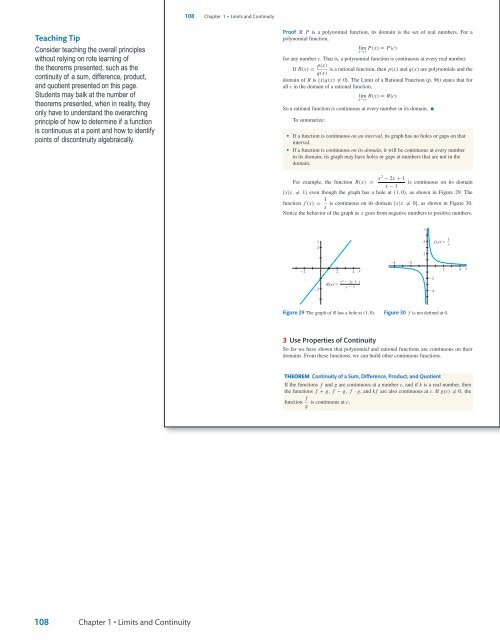Sullivan Microsite DigiSample
You also want an ePaper? Increase the reach of your titles
YUMPU automatically turns print PDFs into web optimized ePapers that Google loves.
<strong>Sullivan</strong> AP˙<strong>Sullivan</strong>˙Chapter01 October 8, 2016 17:4<br />
<strong>Sullivan</strong><br />
108 Chapter 1 • Limits and Continuity<br />
Teaching Tip<br />
Consider teaching the overall principles<br />
without relying on rote learning of<br />
the theorems presented, such as the<br />
continuity of a sum, difference, product,<br />
and quotient presented on this page.<br />
Students may balk at the number of<br />
theorems presented, when in reality, they<br />
only have to understand the overarching<br />
principle of how to determine if a function<br />
is continuous at a point and how to identify<br />
points of discontinuity algebraically.<br />
Proof If P is a polynomial function, its domain is the set of real numbers. For a<br />
polynomial function,<br />
lim P(x) = P(c)<br />
x→c<br />
for any number c. That is, a polynomial function is continuous at every real number.<br />
If R(x) = p(x) is a rational function, then p(x) and q(x) are polynomials and the<br />
q(x)<br />
domain of R is {x|q(x) = 0}. The Limit of a Rational Function (p. 96) states that for<br />
all c in the domain of a rational function,<br />
lim R(x) = R(c)<br />
x→c<br />
So a rational function is continuous at every number in its domain. ■<br />
To summarize:<br />
• If a function is continuous on an interval, its graph has no holes or gaps on that<br />
interval.<br />
• If a function is continuous on its domain, it will be continuous at every number<br />
in its domain; its graph may have holes or gaps at numbers that are not in the<br />
domain.<br />
For example, the function R(x) = x 2 − 2x + 1<br />
is continuous on its domain<br />
x − 1<br />
{x|x = 1} even though the graph has a hole at (1, 0), as shown in Figure 29. The<br />
function f (x) = 1 is continuous on its domain {x|x = 0}, as shown in Figure 30.<br />
x<br />
Notice the behavior of the graph as x goes from negative numbers to positive numbers.<br />
y<br />
y<br />
2<br />
4<br />
2<br />
f (x) 1 x<br />
2<br />
2<br />
4<br />
x<br />
4<br />
2<br />
2<br />
4<br />
x<br />
2<br />
R(x) x2 2x 1<br />
x 1<br />
2<br />
4<br />
Figure 29 The graph of R has a hole at (1, 0).<br />
Figure 30 f is not defined at 0.<br />
3 Use Properties of Continuity<br />
So far we have shown that polynomial and rational functions are continuous on their<br />
domains. From these functions, we can build other continuous functions.<br />
THEOREM Continuity of a Sum, Difference, Product, and Quotient<br />
If the functions f and g are continuous at a number c, and if k is a real number, then<br />
the functions f + g, f − g, f · g, and kf are also continuous at c. If g(c) = 0, the<br />
function f is continuous at c.<br />
g<br />
108<br />
Chapter 1 • Limits and Continuity<br />
TE_<strong>Sullivan</strong>_Chapter01_PART I.indd 5<br />
11/01/17 9:58 am




